2023-2024学年英语鲁教版(五四学制)六年级下册Unit 5How do you get to school ?单元习题课件 (共24张PPT)
文档属性
| 名称 | 2023-2024学年英语鲁教版(五四学制)六年级下册Unit 5How do you get to school ?单元习题课件 (共24张PPT) |  | |
| 格式 | pptx | ||
| 文件大小 | 373.8KB | ||
| 资源类型 | 教案 | ||
| 版本资源 | 鲁教版 | ||
| 科目 | 英语 | ||
| 更新时间 | 2024-07-05 20:33:09 | ||
图片预览


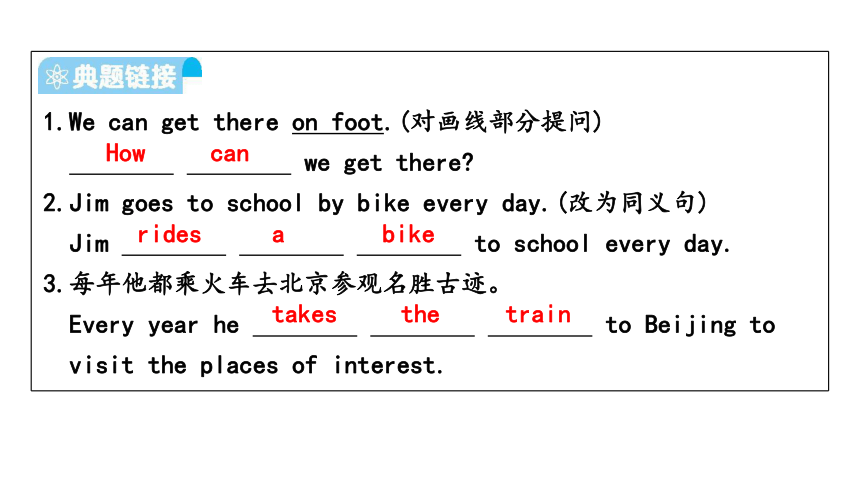
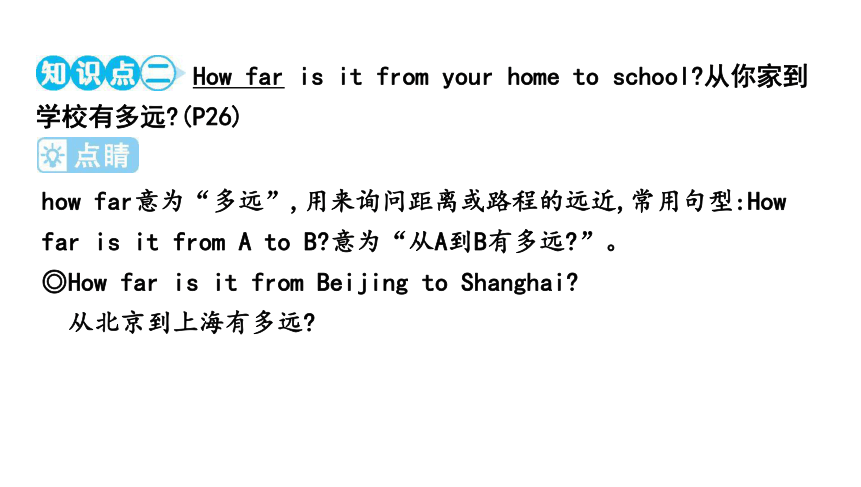
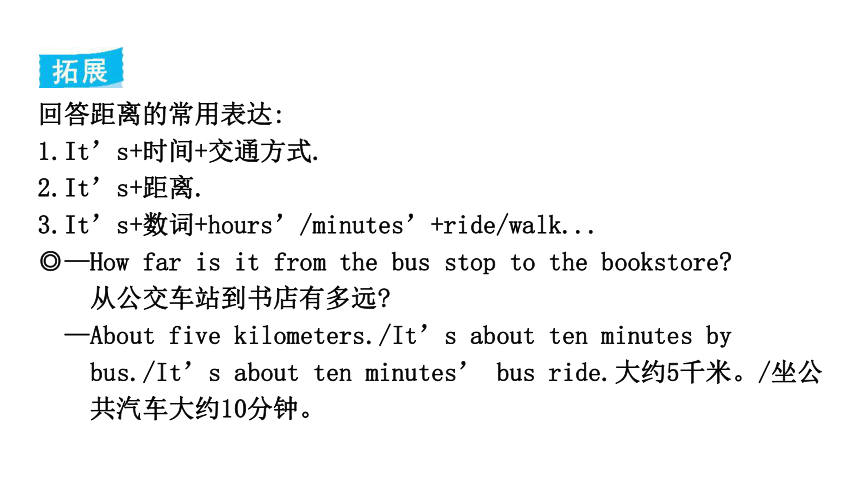
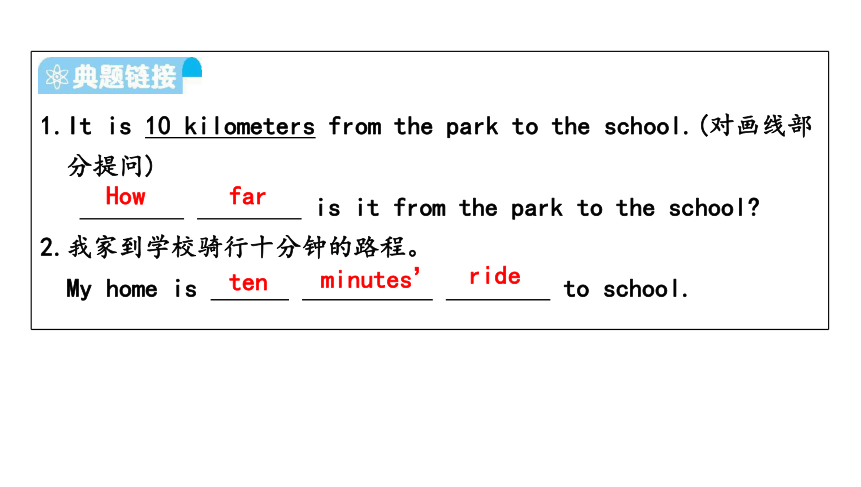
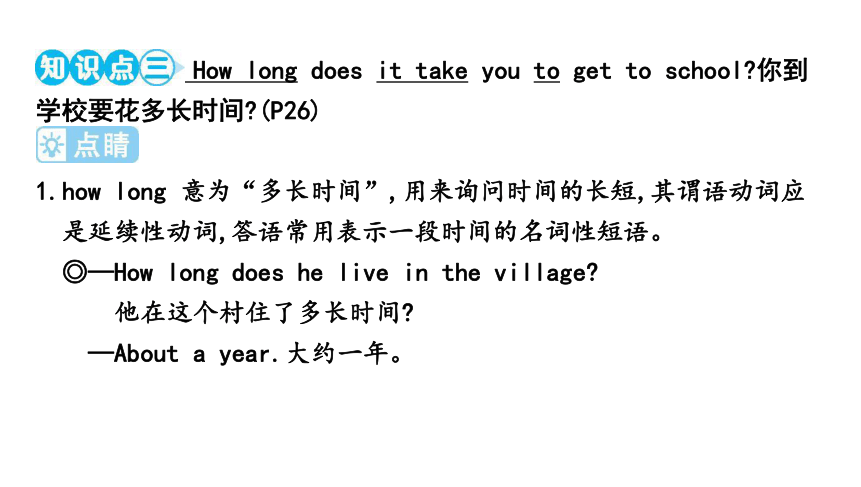
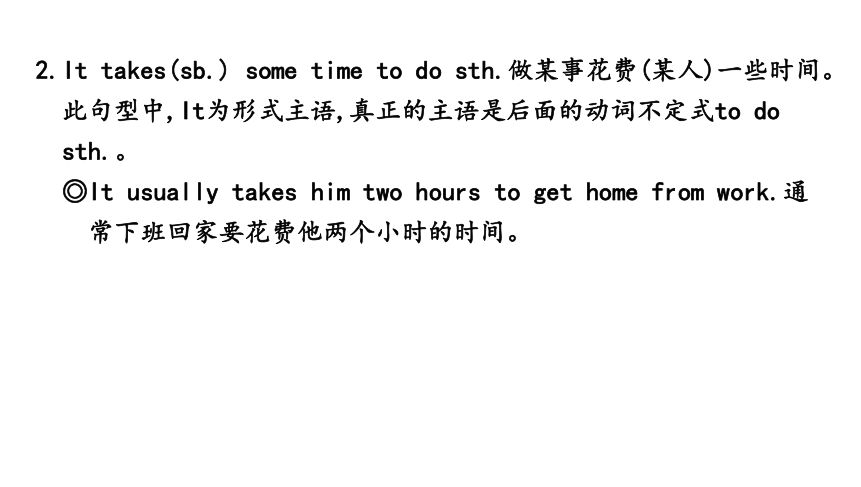
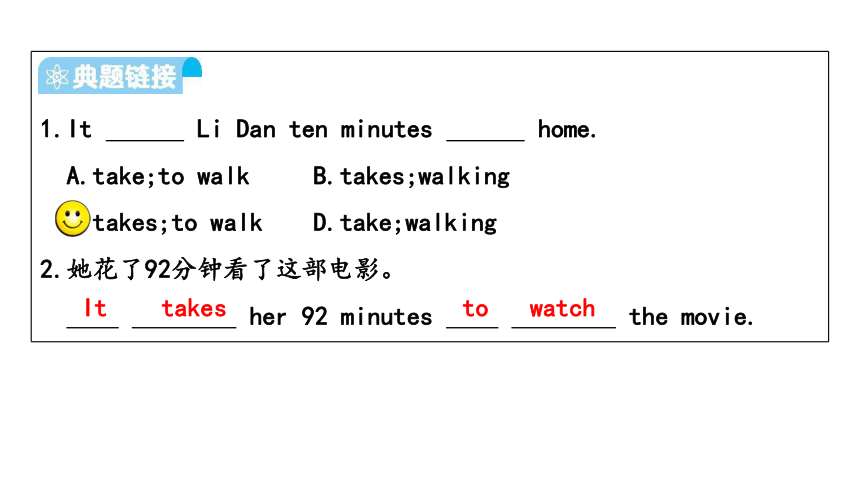
文档简介
(共24张PPT)
Section A
How do you get to school 你怎么去学校 (P25)
“How do/does sb.get to... ” 意为“某人如何到达…… ”,这是用来询问交通方式的交际用语。其答语主要有以下几种:
1.We can get there on foot.(对画线部分提问)
we get there
2.Jim goes to school by bike every day.(改为同义句)
Jim to school every day.
3.每年他都乘火车去北京参观名胜古迹。
Every year he to Beijing to
visit the places of interest.
How
can
rides
a
bike
takes
the
train
How far is it from your home to school 从你家到学校有多远 (P26)
how far意为“多远”,用来询问距离或路程的远近,常用句型:How far is it from A to B 意为“从A到B有多远 ”。
◎How far is it from Beijing to Shanghai
从北京到上海有多远
回答距离的常用表达:
1.It’s+时间+交通方式.
2.It’s+距离.
3.It’s+数词+hours’/minutes’+ride/walk...
◎—How far is it from the bus stop to the bookstore
从公交车站到书店有多远
—About five kilometers./It’s about ten minutes by
bus./It’s about ten minutes’ bus ride.大约5千米。/坐公
共汽车大约10分钟。
1.It is 10 kilometers from the park to the school.(对画线部
分提问)
is it from the park to the school
2.我家到学校骑行十分钟的路程。
My home is to school.
How
far
ten
minutes’
ride
How long does it take you to get to school 你到学校要花多长时间 (P26)
1.how long 意为“多长时间”,用来询问时间的长短,其谓语动词应
是延续性动词,答语常用表示一段时间的名词性短语。
◎—How long does he live in the village
他在这个村住了多长时间
—About a year.大约一年。
2.It takes(sb.) some time to do sth.做某事花费(某人)一些时间。
此句型中,It为形式主语,真正的主语是后面的动词不定式to do
sth.。
◎It usually takes him two hours to get home from work.通
常下班回家要花费他两个小时的时间。
1.It Li Dan ten minutes home.
A.take;to walk B.takes;walking
C.takes;to walk D.take;walking
2.她花了92分钟看了这部电影。
her 92 minutes the movie.
It
to
takes
watch
Section B
what he thinks of the trip他认为这次旅行怎么样(P28)
“What do you think of... ”也可表达为“What do you think about... ”,相当于“How do you like... ”,意为“你以为……怎么样 ”,用于询问对方对某人(物)的看法。
◎What do you think of the book =How do you like the book 你
以为这本书怎么样
1.The school trip is tired but exciting.(对画线部分提问)
the school
trip
2.How do you like your new school (改为同义句)
do you your new school
What
do
you
think
of/about
What
think
of
For many students, it is easy to get to school.对许多学生来说,到达学校很容易。(P29)
本句是“It is+ adj.+(of/for sb.+) to do sth.”结构,意为“(某人/对某人来说) 做某事是……的”。其中it 为形式主语,后面的动词不定式短语to do sth.是真正的主语。本句为了强调,把for many students 放到了句首。正常的语序应是“It is easy for many students to get to school.”。
辨析:It is+ adj.+for/of sb.+to do sth.句型中的for 和of
It’s+ adj.+for sb.+to do sth. 该句式中的形容词描述事物的特征,如easy,difficult,interesting,funny,important,useful等
It’s+ adj.+of sb.+to do sth. 该句式中的形容词描述人的性格、品质,如kind,friendly,nice,clever等
◎It is difficult for me to speak French.对我来说,说法语是困
难的。
◎It’s kind of you to help me.你能帮我真是太好了。
1.It’s nice of you me with my math.
A.help B.helping
C.to help D.to helping
2.It’s difficult the students get to school
in Yunnan.
A.for;for B.to;for C.for;to D.to;to
3.对于我们来说,学好英语非常重要。
.
It is very important for us to learn English well.
One 11-year-old boy,Liangliang,crosses the river every school day.一个名叫梁亮的11岁男孩每天上学都要过河。(P29)
11-year-old是复合形容词,其构成形式是:“数词+名词+形容词”,中间加连字符。名词必须用单数形式。只能用作定语。注意前面的冠词要依据数字的首字母读音音素确定。
◎He has a one-year-old son.他有一个一岁大的儿子。
◎The winner is an eight-year-old girl.获奖者是一位8岁大的
小姑娘。
辨析:11-year-old 与11 years old
11-year-old 用连字符连接,中间的名词用单数,在句中作定语
11 years old 不用连字符连接,基数词大于1时,中间的名词用复数,在句中作表语
◎He is an 11-year-old boy.他是一个11岁的男孩。
◎She is 11 years old.她11 岁了。
1.I have a sister.
A.9-years-old B.9 years old
C.9-year-old D.9 year old
2.Every one of them felt tired but quite happy after
sports meeting.
A.the two-day B.two-day
C.two days D.two-days
But he is not afraid.但是他不害怕。(P29)
afraid 作形容词,意为“害怕的;畏惧的”。afraid常放在be动词后,其用法如下:
1.那个小女孩害怕狗,因而她不敢养宠物狗。
The little girl dogs,so she
have a pet dog.
2.恐怕你不能在这儿吸烟。
you can’t smoke here.
is
is
afraid
of
afraid
to
I’m
afraid
He’s like a father to me.他就像我的父亲。(P29)
like 在此处作介词,意为“像”。
辨析:be like 和look like
be like“像”,多指性格、品质方面像,也可指外貌上像;
look like “看起来像”,指外观或外貌上像。
◎The girl is like her sister.They’re both outgoing.
这个女孩像她姐姐。她们都很外向。
◎The cloud looks like a horse.
这朵云看上去像一匹马。
What’s sb.like 某人怎么样 (侧重于询问性格、品质)
What does sb.look like 某人长得什么样 (侧重于询问外表)
1.Jim is very outgoing and kind.(对画线部分提问)
Jim
2.My English teacher is tall and thin.(对画线部分提问)
your English teacher .
发
What
like
is
What
does
look
like
谢谢观赏!
Section A
How do you get to school 你怎么去学校 (P25)
“How do/does sb.get to... ” 意为“某人如何到达…… ”,这是用来询问交通方式的交际用语。其答语主要有以下几种:
1.We can get there on foot.(对画线部分提问)
we get there
2.Jim goes to school by bike every day.(改为同义句)
Jim to school every day.
3.每年他都乘火车去北京参观名胜古迹。
Every year he to Beijing to
visit the places of interest.
How
can
rides
a
bike
takes
the
train
How far is it from your home to school 从你家到学校有多远 (P26)
how far意为“多远”,用来询问距离或路程的远近,常用句型:How far is it from A to B 意为“从A到B有多远 ”。
◎How far is it from Beijing to Shanghai
从北京到上海有多远
回答距离的常用表达:
1.It’s+时间+交通方式.
2.It’s+距离.
3.It’s+数词+hours’/minutes’+ride/walk...
◎—How far is it from the bus stop to the bookstore
从公交车站到书店有多远
—About five kilometers./It’s about ten minutes by
bus./It’s about ten minutes’ bus ride.大约5千米。/坐公
共汽车大约10分钟。
1.It is 10 kilometers from the park to the school.(对画线部
分提问)
is it from the park to the school
2.我家到学校骑行十分钟的路程。
My home is to school.
How
far
ten
minutes’
ride
How long does it take you to get to school 你到学校要花多长时间 (P26)
1.how long 意为“多长时间”,用来询问时间的长短,其谓语动词应
是延续性动词,答语常用表示一段时间的名词性短语。
◎—How long does he live in the village
他在这个村住了多长时间
—About a year.大约一年。
2.It takes(sb.) some time to do sth.做某事花费(某人)一些时间。
此句型中,It为形式主语,真正的主语是后面的动词不定式to do
sth.。
◎It usually takes him two hours to get home from work.通
常下班回家要花费他两个小时的时间。
1.It Li Dan ten minutes home.
A.take;to walk B.takes;walking
C.takes;to walk D.take;walking
2.她花了92分钟看了这部电影。
her 92 minutes the movie.
It
to
takes
watch
Section B
what he thinks of the trip他认为这次旅行怎么样(P28)
“What do you think of... ”也可表达为“What do you think about... ”,相当于“How do you like... ”,意为“你以为……怎么样 ”,用于询问对方对某人(物)的看法。
◎What do you think of the book =How do you like the book 你
以为这本书怎么样
1.The school trip is tired but exciting.(对画线部分提问)
the school
trip
2.How do you like your new school (改为同义句)
do you your new school
What
do
you
think
of/about
What
think
of
For many students, it is easy to get to school.对许多学生来说,到达学校很容易。(P29)
本句是“It is+ adj.+(of/for sb.+) to do sth.”结构,意为“(某人/对某人来说) 做某事是……的”。其中it 为形式主语,后面的动词不定式短语to do sth.是真正的主语。本句为了强调,把for many students 放到了句首。正常的语序应是“It is easy for many students to get to school.”。
辨析:It is+ adj.+for/of sb.+to do sth.句型中的for 和of
It’s+ adj.+for sb.+to do sth. 该句式中的形容词描述事物的特征,如easy,difficult,interesting,funny,important,useful等
It’s+ adj.+of sb.+to do sth. 该句式中的形容词描述人的性格、品质,如kind,friendly,nice,clever等
◎It is difficult for me to speak French.对我来说,说法语是困
难的。
◎It’s kind of you to help me.你能帮我真是太好了。
1.It’s nice of you me with my math.
A.help B.helping
C.to help D.to helping
2.It’s difficult the students get to school
in Yunnan.
A.for;for B.to;for C.for;to D.to;to
3.对于我们来说,学好英语非常重要。
.
It is very important for us to learn English well.
One 11-year-old boy,Liangliang,crosses the river every school day.一个名叫梁亮的11岁男孩每天上学都要过河。(P29)
11-year-old是复合形容词,其构成形式是:“数词+名词+形容词”,中间加连字符。名词必须用单数形式。只能用作定语。注意前面的冠词要依据数字的首字母读音音素确定。
◎He has a one-year-old son.他有一个一岁大的儿子。
◎The winner is an eight-year-old girl.获奖者是一位8岁大的
小姑娘。
辨析:11-year-old 与11 years old
11-year-old 用连字符连接,中间的名词用单数,在句中作定语
11 years old 不用连字符连接,基数词大于1时,中间的名词用复数,在句中作表语
◎He is an 11-year-old boy.他是一个11岁的男孩。
◎She is 11 years old.她11 岁了。
1.I have a sister.
A.9-years-old B.9 years old
C.9-year-old D.9 year old
2.Every one of them felt tired but quite happy after
sports meeting.
A.the two-day B.two-day
C.two days D.two-days
But he is not afraid.但是他不害怕。(P29)
afraid 作形容词,意为“害怕的;畏惧的”。afraid常放在be动词后,其用法如下:
1.那个小女孩害怕狗,因而她不敢养宠物狗。
The little girl dogs,so she
have a pet dog.
2.恐怕你不能在这儿吸烟。
you can’t smoke here.
is
is
afraid
of
afraid
to
I’m
afraid
He’s like a father to me.他就像我的父亲。(P29)
like 在此处作介词,意为“像”。
辨析:be like 和look like
be like“像”,多指性格、品质方面像,也可指外貌上像;
look like “看起来像”,指外观或外貌上像。
◎The girl is like her sister.They’re both outgoing.
这个女孩像她姐姐。她们都很外向。
◎The cloud looks like a horse.
这朵云看上去像一匹马。
What’s sb.like 某人怎么样 (侧重于询问性格、品质)
What does sb.look like 某人长得什么样 (侧重于询问外表)
1.Jim is very outgoing and kind.(对画线部分提问)
Jim
2.My English teacher is tall and thin.(对画线部分提问)
your English teacher .
发
What
like
is
What
does
look
like
谢谢观赏!
同课章节目录
- Unit 1 When is your birthday?
- Section A
- Section B
- Unit 2 My favourite subject is science
- Section A
- Section B
- Unit 3 Can you play the guitar?
- Section A
- Section B
- Unit 4 What time do you go to school?
- Section A
- Section B
- Unit 5 How do you get to school?
- Section A
- Section B
- Unit 6 Don't eat in class.
- Section A
- Section B
- Unit 7 Why do you like pandas?
- Section A
- Section B
- Unit 8 I'm watching TV.
- Section A
- Section B
- Unit 9 It's raining!
- Section A
- Section B
- Unit 10 Is there a post office near here?
- Section A
- Section B
